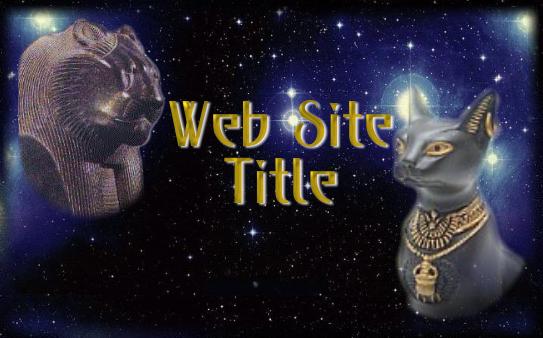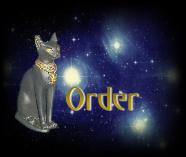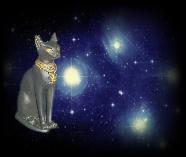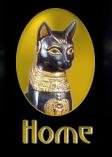|

The inspiration for
this web set is the Egyptian goddess Bast (also known as,
Bastet, Ubast and Pasht). Early statuary and carvings of Bast
are often confused with Sekmet (Sekhet, Sehkmet) because Bast in Lower
Egypt was depicted as a lion headed female. Later she evolved
into a cat headed goddess and finally in the Middle Kingdom was
depicted as we most commonly know her today, as a domestic cat.
The title graphic above is a sample of how the graphic looks with a web
site title. The .zip file has a blank title graphic for you
to insert a title on. If you do not have a graphic program
capable of doing that, e-mail
me and I will do it as time allows. The font I
used on the sample title and buttons is called "P22 Escher."
Below you will find an Egyptian Bast divider, bullets and buttons
designed for
this web set.

 |
In
ancient Egypt the cat was worshipped as a sacred animal - the mother or
creator. Bast originally was the creator goddess of Lower
Egypt, and was depicted as a woman with a lion's head. She
has been dated to at least the Second Dynasty (c. 2890-2686 Before
Common Era [B.C.E.]). Bast is the Egyptian Goddess and
protector of cats, women and children. Her goddess duties
changed over the years, so she is also known as a goddess of love,
fertility, birth, music and dance. Bast was originally a
goddess of the sunrise, but later this was changed by the Greeks to a
goddess of the moon. In Greek mythology, Bast is also known
as Aelurus.
|
 |
Later
scribes sometimes named her Bastet, a variation on Bast consisting of
an additional feminine suffix to the one already present, thought to
have been added to emphasise pronunciation. Since Bastet
would literally mean (female) of the ointment jar, Bast gradually
became thought of as the goddess of perfumes, earning the title
perfumed protector.
|
 |
This
gentler characteristic, of Bast as goddess of perfumes, together with
Lower Egypt's loss in the wars between Upper & Lower Egypt, led
to a decrease in her ferocity. Thus, by the Middle Kingdom
she was generally regarded as a domestic cat rather than a
lionness. Occasionally, however, she was depicted holding a
lionness mask, which hinted at suppressed ferocity.
|
 |
Due
to the severe disaster to the food supply that could be caused by
simple vermin such as mice and rats, and their ability to fight and
kill snakes, especially cobras, cats in Egypt were revered heavily,
sometimes being given golden jewelry to wear, and being allowed to eat
from the same plates as their owners. Consequently, as the
main cat (rather than lion) deity, Bast was strongly revered as the
patron of cats, and thus it was in the temple at Per-Bast that dead
(and mummified) cats were brought for burial. Over 300,000
mummified cats were discovered when Bast's temple at Per-Bast was
excavated.
|
 |
There
is some confusion over Bast and Sekhmet. Bast and Sekhmet are
not the same goddess (unlike Hathor who becomes Sekhmet as the 'Eye of
Ra'). Bast and Sekhmet were another example of
Egyptian duality - Sekhmet was a goddess of Upper Egypt, Bast of Lower
Egypt (just like the pharaoh was of Upper and/or Lower Egypt)... and
they were linked together by geography, not by myth or
legend. These two feline goddesses were not related by
family, they were both very distinct goddesses in their own rights.
|

 
 
To save, you may download
the .zip file which includes the egyptian graphics and HTML
template. Do not link to the graphics on this page!
Please note that this set is free to use on personal websites
only. Those sites that hope to generate income (business
site) there is a one time requested minimum $10 donation to use this
egyptian graphic web set. You may make the donation through Pay Pal
(mail donations to mail@kytheraann.com).
Whether it is a commercial or personal web site, please use
the graphic below for any page you use these designs on.

Thank
you
|










